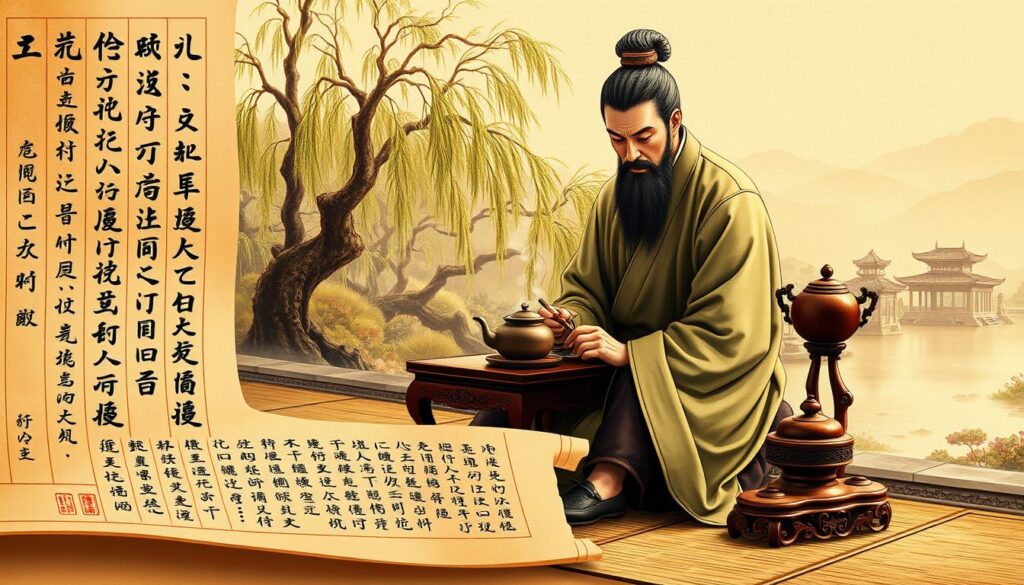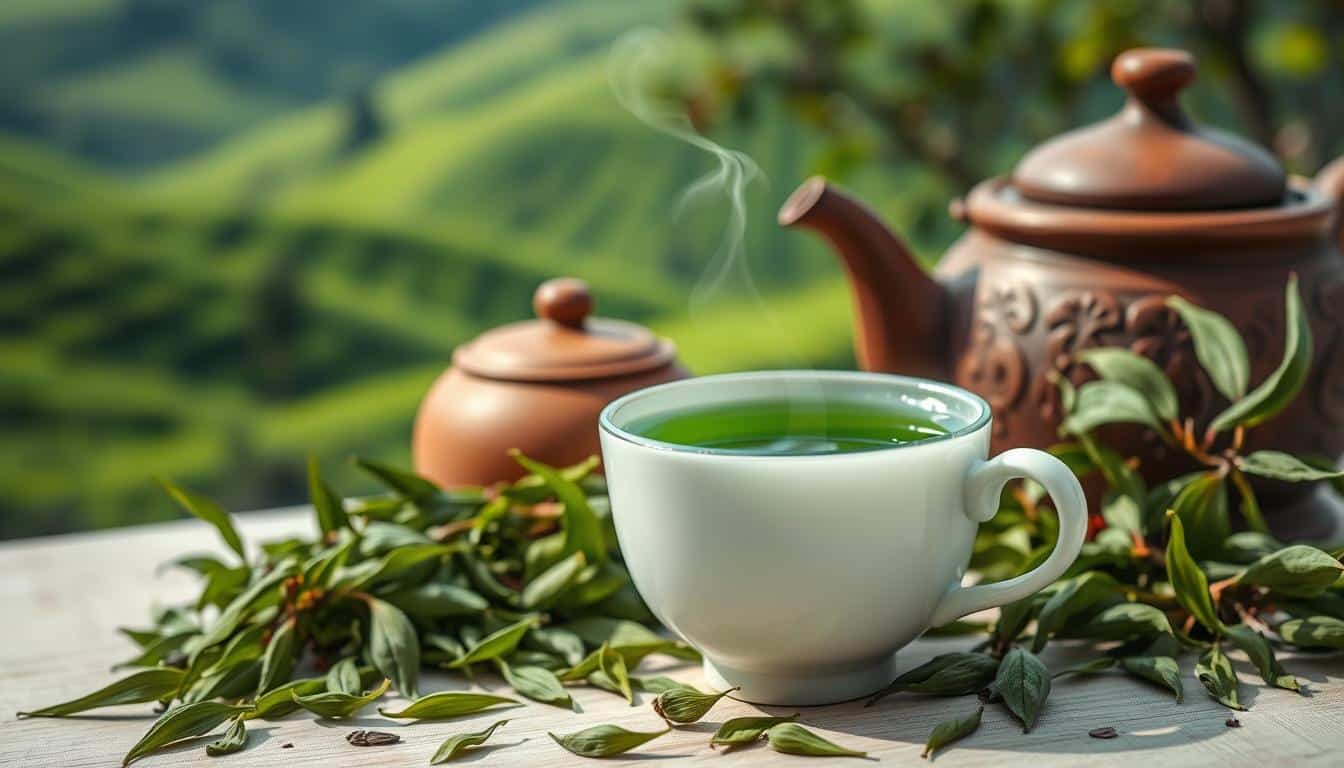Did you know China Green Tea has been enjoyed for over 4,000 years? This tradition started in 2737 BC when Emperor Shennong found tea by accident. It became a symbol of culture and a favorite drink. A simple cup of Chinese green tea is older than many civilizations! 📜🍵
Green tea in China means more than just a tasty drink. It was once only for the rich but became common in the 14th century. It has shaped food, social, religious, and health practices in Asia. This ancient tea is a key part of Chinese culture, linking past and present.
Key Takeaways
- China green tea has been enjoyed for over 4,000 years, dating back to 2737 BC.
- Emperor Shennong’s legendary discovery laid the foundation for tea culture in China.
- Originally a luxury item, authentic Chinese green tea became accessible to the public in the 14th century.
- Its impact spans culinary, social, religious, and medicinal contexts.
- Green tea remains a powerful symbol of Chinese cultural heritage.
- Understanding the history of green tea offers insight into its cultural significance.
Ancient Origins of China Green Tea
The history of China green tea is filled with legend and fact. It mixes mythical tales with real farming practices from thousands of years ago. Let’s look at how this special drink started.
The Legend of Emperor Shennong
Legend says Emperor Shennong found china green tea around 2737 BC. He was boiling water when tea leaves fell in, making a tasty drink. He loved it and started learning about its health benefits.
This chance find was the start of what we call premium loose leaf tea today.
Early Cultivation During Han Dynasty
The Han Dynasty was key for china green tea. It was when tea farming became more organized. Farmers learned how to grow, pick, and process tea leaves better.
This work helped tea become important in Chinese culture. It also made tea a big part of their lives.
Looking into these stories, we see tea is more than a drink. It’s a mix of tradition, new ideas, and cultural value. For more on this, check out the history and cultural significance of China green tea.
The Tang Dynasty and the Classic of Tea
The Tang Dynasty was a golden time for Chinese culture. It was also when tea became very important. Lu Yu’s work was key in understanding tea culture.
The Classic of Tea by Lu Yu
Around 800 AD, Lu Yu wrote The Classic of Tea. It was the first big book about tea. He talked about growing, making, and drinking tea.
This book helped make green tea popular in China. We learn a lot about green tea from Lu Yu’s work.
Green Tea as a National Drink
Lu Yu made tea more than just a drink. It became a symbol of Chinese culture. In the Tang Dynasty, green tea became loved by everyone.
Its beauty and health benefits made it a favorite. This love for tea started a tradition that still exists today.

| Aspect | Description | Impact |
|---|---|---|
| Author | Lu Yu | Standardized tea culture during the Tang Dynasty |
| Treatise | The Classic of Tea | First comprehensive work on tea cultivation and preparation |
| National Drink | Green Tea | Became a cultural and social staple in China |
| Popular Products | Various green tea types | Influenced by Lu Yu’s teachings, beloved for health benefits |
Spread of Green Tea Throughout Asia
The journey of green tea in Asia is amazing. It shows how cultures have changed over time. The tea leaf has traveled far, becoming important in many places.
In the 9th century, monks from China brought green tea to Japan. This changed Japan’s way of life and culture. Japan’s tea culture grew, mixing with spiritual practices.
Introduction to Japan
In Japan, green tea became a special part of daily life. It was seen as a way to be mindful and connect with others. The Japanese tea ceremony, or ‘chanoyu’, is a calm, planned event.
It shows the Japanese way of life. You can also buy green tea online to try this tradition yourself.

Korean Tea Traditions
Green tea arrived in Korea in the 7th century. Korean tea ceremonies, or ‘darye’, aim for calm and peace. They focus on making tea pure and simple.
Each tea moment in Korea is a nod to its long history. It keeps green tea’s heritage alive.
Today, people still love these tea traditions. They show how green tea has connected cultures over time.
Cultural Significance and Modern Importance of China Green Tea
Green tea is deeply rooted in many Asian cultures. It’s used in religious ceremonies and social rituals. It symbolizes respect, hospitality, and a connection to nature.
The way it’s prepared and drunk shows the rich traditions passed down through generations.
Religious and Social Significance
In Asia, green tea is more than a drink. It’s a spiritual experience. Zen Buddhists in Japan use it in meditation.
The act of brewing and drinking green tea promotes mindfulness. This is key in many spiritual practices. Chinese tea ceremonies also show the cultural significance of green tea.
Artistic and Economic Impact
Green tea’s influence goes beyond culture. It inspires art and has economic benefits. Artists have been inspired by green tea in their work.
Tea houses and gardens show its artistic impact. They celebrate tranquility and natural beauty.
The economic impact of green tea is significant. It supports many jobs, from farmers to traders. Green tea is a big part of the tea market.
| Aspect | Cultural Significance | Economic Impact |
|---|---|---|
| Religious Ceremonies | Integral | Moderate |
| Social Rituals | High | Moderate |
| Artistic Inspiration | High | Low |
| Trade and Commerce | Moderate | High |
Green tea’s cultural, artistic, and economic value is clear. It’s important today and was in the past. Embracing green tea keeps its legacy alive.
Health Benefits of Green Tea
Exploring the health benefits of green tea shows many advantages. These benefits are still important today. They come from green tea’s special properties.
Chlorophyll, Polyphenols, and Antioxidants
Green tea has chlorophyll, polyphenols, and antioxidants. These help protect our cells from harm. Catechins, especially EGCG, are key in preventing cell damage.
You can learn more about green tea’s health benefits. They can improve your health a lot. Check out the health benefits of green tea online.
Studies on Cardiovascular Health and Brain Function
Many studies show green tea’s good effects on heart health. Its antioxidants lower inflammation and improve cholesterol. This reduces heart disease risk.
Green tea also helps prevent cognitive decline. A 2020 study found it improves brain function. It helps with better thinking and mood.
For those living mindfully, green tea is a great choice. It can lower cancer risk and help with weight. Green tea’s many health benefits make it special.
Conclusion
The story of China green tea is truly magical. It started with Emperor Shennong’s discovery and has become a key part of global wellness. This ancient tea is loved for its health benefits and rich culture.
Green tea has grown from a royal treat to a favorite in homes everywhere. It’s loved for its taste and health perks. It’s good for your heart and brain, making it a special part of our lives.
Adding green tea to your day is a great way to care for yourself. Whether you’re looking for the best brand or want to try authentic Chinese green tea, it’s a path to wellness. Learn more about green tea’s benefits and find the best green tea brand for you.


